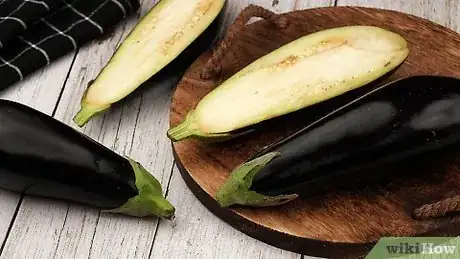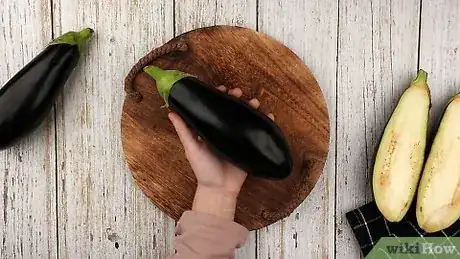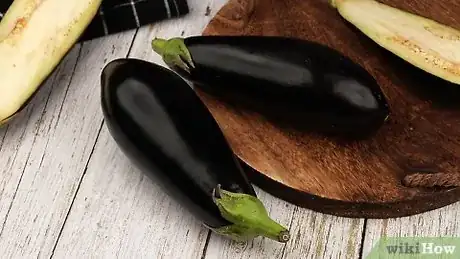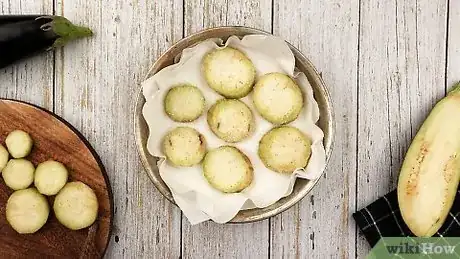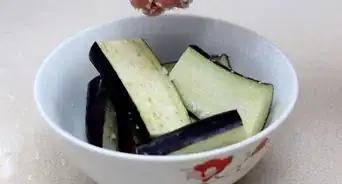This article was co-authored by wikiHow Staff. Our trained team of editors and researchers validate articles for accuracy and comprehensiveness. wikiHow's Content Management Team carefully monitors the work from our editorial staff to ensure that each article is backed by trusted research and meets our high quality standards.
The wikiHow Video Team also followed the article's instructions and verified that they work.
This article has been viewed 25,416 times.
Learn more...
Eggplant is a hearty vegetable that's as delicious as it is healthy and packed with antioxidants. If you're going to cook the vibrant veggie, you need to prepare it properly first. Start by picking the perfectly ripe eggplant based on its color and size. Then, cut the eggplant, peeling it if you'd like, and salt the vegetable if you want to bring out its flavor and prevent it from getting soggy when you cook it. Bon appetit!
Steps
Choosing an Eggplant
-
1Look for smooth and shiny skin. If an eggplant is wrinkled, it means it was harvested a while ago and isn’t as fresh. Choose one that has taut skin and a slight sheen rather than one that’s dull.[1]
- Avoid eggplants that have bruises or blemishes, too, which make the vegetable more vulnerable to bacteria and can form mold.
-
2Opt for small- to medium-sized eggplants if you want better flavor. Stay away from the biggest eggplants on the shelf, as the larger the vegetable, the more bitter and stringy it is. Pick the smaller ones to get the best taste.[2]
- A good rule of thumb is to choose an eggplant that’s slightly larger than your hand.
Advertisement -
3Pick an eggplant that has a green, firm stem. Pay attention to the stem of the eggplant. Select one that is a bright green and that isn’t soft or mushy. If you notice any mold or signs of decay around the stem, don’t choose that vegetable.[3]
- Stay away from eggplant that has a brown or visibly dried out stem.
-
4Store your eggplant at room temperature for 3 to 5 days. Once you pick out your eggplant, keep it somewhere that’s room temperature, dry, and out of direct sunlight. Use it within 5 days while it’s still fresh.[4]
- Throw the eggplant away if you notice any mold or rotting.
- Keep the eggplant separate from other fruits and vegetables, like apples or bananas, because it's very sensitive to ethylene, which is the gas produce gives off as it ripens. If you don’t separate the eggplant, it will go bad faster.
Tip: Only put the eggplant in the refrigerator if your kitchen is very hot and humid, as eggplants don’t hold up well in the cold.
Cutting and Peeling Eggplant
-
1Trim off the top and bottom of the eggplant. Place the eggplant on a cutting board and hold it securely with one hand. Then use a sharp knife to slice off the top where the leaves are and the bottom of the vegetable.[5]
- Cut as little as possible off the eggplant. Only trim off enough to remove the leaves and stem.
-
2Peel the eggplant if you want to remove the bitter skin. Run a vegetable peeler in long strokes down the length of the eggplant. Press firmly as you go to ensure the blade of the peeler is removing the thick outer skin. Continue until all of the skin is gone from the vegetable.[6]
- If you don’t have a vegetable peeler, you can use a paring knife to carefully shave off the skin.
- Peel the eggplant right before you plan on using it since the inside will discolor once it’s peeled if you let it sit out.
-
3Slice the eggplant into the shape of your choice. With the same knife you used to trim the ends, cut the eggplant into whatever shape and size your recipe calls for. If a recipe doesn't require a specific cut, choose from round slices, cubes, or strips, for example.[7]
- Make the pieces as equal in width as possible. For instance, you don’t want one slice to be very thin while another is very thick. Choose one width and stick to it.
- If you're cutting rounds, which are the easiest to slice, keep them 1⁄2 to 1 in (1.3 to 2.5 cm) thick so they cook evenly.
Tip: If you're stuffing, roasting, or grilling the eggplant, for example, you can simply cut it in half lengthwise.
Salting Eggplant
-
1Place the eggplant pieces in a single layer on a paper towel-lined baking sheet. Lay paper towels over a flat baking sheet. Then, arrange the slices of eggplant on top of the paper towels so that none of the pieces overlap.[8]
- You can also use parchment paper or a clean cotton cloth instead of paper towels.
Tip: If you diced or cubed your eggplant, you can place the pieces in a colander instead of laying them out on a baking sheet.
-
2Sprinkle both sides of the slices with 1/2 tbsp (9 g) of kosher salt. Make sure one side is completely coated in salt before flipping the rounds over. Then sprinkle on the rest of the salt so that both sides are covered.[9]
- Use more than 1/2 tbsp (9 g) of salt if you have an eggplant that’s larger than about 8 inches (20 cm) long.
-
3Let the eggplant sit for at least 30 minutes. After salting the slices, leave them for about 20 minutes so the salt can draw out any bitterness. Don’t let the eggplant soak for more than 1.5 hours.[10]
- Place the baking sheet somewhere room temperature and out of reach of any pets or young children.
- It’s normal if you notice beads of “sweat” on top of the slices as they soak or if you see them shrivel slightly.
-
4Dab the eggplant slices with a paper towel to remove extra liquid and salt. When the 20 minutes is up, take a paper towel and pat down both sides of each round. Use gentle pressure so you soak up the excess salt and sweat without drying out the eggplant.[11]
- If you don’t want any salt remaining on your eggplant after it has drawn out the excess liquid, you can rinse the slices in the sink and drain them before cooking.
Community Q&A
Did you know you can get answers researched by wikiHow Staff?
Unlock staff-researched answers by supporting wikiHow
-
QuestionWhat should I look for when buying eggplants?
 wikiHow Staff EditorThis answer was written by one of our trained team of researchers who validated it for accuracy and comprehensiveness.
wikiHow Staff EditorThis answer was written by one of our trained team of researchers who validated it for accuracy and comprehensiveness.
Staff Answer wikiHow Staff EditorStaff Answer
wikiHow Staff EditorStaff Answer -
QuestionHow long will eggplant keep for when stored?
 wikiHow Staff EditorThis answer was written by one of our trained team of researchers who validated it for accuracy and comprehensiveness.
wikiHow Staff EditorThis answer was written by one of our trained team of researchers who validated it for accuracy and comprehensiveness.
Staff Answer wikiHow Staff EditorStaff Answer
wikiHow Staff EditorStaff Answer -
QuestionWhy does my eggplant use so much oil when frying?
 wikiHow Staff EditorThis answer was written by one of our trained team of researchers who validated it for accuracy and comprehensiveness.
wikiHow Staff EditorThis answer was written by one of our trained team of researchers who validated it for accuracy and comprehensiveness.
Staff Answer wikiHow Staff EditorStaff AnswerEggplants are porous and easily soak up liquid. To reduce the amount of oil an eggplant soaks up in cooking, it is important to salt the slices or halves first. Doing this draws out the moisture present in the eggplant and helps reduce the oil uptake. However, even with salting, eggplant will absorb quite a lot of oil, so it's helpful to expect this to happen and account for it when cooking eggplant.
wikiHow Staff EditorStaff AnswerEggplants are porous and easily soak up liquid. To reduce the amount of oil an eggplant soaks up in cooking, it is important to salt the slices or halves first. Doing this draws out the moisture present in the eggplant and helps reduce the oil uptake. However, even with salting, eggplant will absorb quite a lot of oil, so it's helpful to expect this to happen and account for it when cooking eggplant.
Things You'll Need
Cutting and Peeling Eggplant
- Cutting board
- Sharp knife
- Vegetable peeler
Salting Eggplant
- Paper towels
- Baking sheet
- Salt
References
- ↑ https://www.bonappetit.com/test-kitchen/ingredients/article/from-the-market-eggplants
- ↑ https://www.bonappetit.com/test-kitchen/ingredients/article/from-the-market-eggplants
- ↑ https://www.thekitchn.com/5-things-to-look-for-when-buying-eggplant-at-the-grocery-store-232836
- ↑ https://www.thekitchn.com/the-best-place-to-store-eggplant-is-not-in-the-refrigerator-174191
- ↑ https://www.goodhousekeeping.com/food-recipes/cooking/tips/g1963/cooking-prep-eggplant/
- ↑ https://www.bhg.com/recipes/how-to/cooking-basics/how-to-cook-eggplant/
- ↑ https://www.goodhousekeeping.com/food-recipes/cooking/tips/g1963/cooking-prep-eggplant/
- ↑ https://www.goodhousekeeping.com/food-recipes/cooking/tips/g1963/cooking-prep-eggplant/
- ↑ https://www.thekitchn.com/soggy-bitter-eggplant-just-add-salt-173792
About This Article
To prepare eggplant, start by cutting off and disposing of the top and bottom of the vegetable. If you want to remove the skin, use a vegetable peeler to do this. Then, cut the eggplant in whatever way you’d like, whether that’s round slices, cubes, or strips. Once you’ve chopped the eggplant, place the pieces on top of paper towels and cover them in salt. Allow the eggplant to sit for 20 to 30 minutes, which will give the salt time to remove any bitterness. You could also rinse the eggplant pieces under water if you don't want them to have a salty flavor. For tips on how to pick a good quality eggplant, read on!
